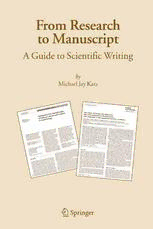
From Research to Manuscript: A Guide to Scientific Writing PDF
Preview From Research to Manuscript: A Guide to Scientific Writing
FROM RESEARCH TO MANUSCRIPT From Research to Manuscript A Guide to Scientific Writing by MICHAEL JAY KATZ Case Western Reserve University, Cleveland OH, U.S.A. A C.I.P. Catalogue record for this book is available from the Library of Congress. ISBN-10 1-4020-4045-8 (PB) ISBN-13 978-1-4020-4045-0 (PB) ISBN-10 1-4020-4071-7 ( e-book) ISBN-13 978-1-4020-4071-9 (e-book) Published by Springer, P.O. Box 17, 3300 AADordrecht, The Netherlands. www.springer.com Printed on acid-free paper All Rights Reserved © 2006 Michael Jay Katz. The exclusive exploitation and distribution rights remain with Springer. No part of this work may be reproduced, stored in a retrieval system, or transmitted in any form or by any means, electronic, mechanical, photocopying, microfilming, recording or otherwise, without written permission from the Publisher, with the exception of any material supplied specifically for the purpose of being entered and executed on a computer system, for exclusive use by the purchaser of the work. Printed in the Netherlands. Contents ACKNOWLEDGEMENTS................................................................ vii INTRODUCTION............................................................................ ix SCIENTIFICPAPERSUSEDASEXAMPLES....................................... xi 1. TOOLSANDTECHNIQUES......................................................... 1 1. TheStandards......................................................................... 1 1.1. AStereotypedFormat........................................................ 1 1.2. PreciseLanguage.............................................................. 1 1.3. ASingle,ClearDirection.................................................... 2 1.4. ReviewedandMadeAvailabletoOthers.................................. 2 2. WordsandText...................................................................... 3 2.1. WritewithExactnessandClarity........................................... 3 2.2. HowtoWriteText............................................................. 6 2.3. AdvicetoSpeakersofOtherLanguages.................................. 24 3. Numbers............................................................................... 25 3.1. Tables............................................................................ 27 3.2. Statistics......................................................................... 30 4. Figures................................................................................. 41 4.1. BasicGuidelines............................................................... 41 4.2. FigureLegends................................................................. 43 4.3. Graphs........................................................................... 43 4.4. AestheticsofNumericalFigures............................................ 48 5. ScientificPatterns.................................................................... 49 2. THESCIENTIFICPAPER............................................................. 51 1. ResearchandWriting............................................................... 51 1.1. DailyLabNotebook........................................................... 51 1.2. ABeginningDraft............................................................. 52 2. WritingtheSectionsofaScientificPaper....................................... 53 2.1. MaterialsandMethods....................................................... 54 v vi Contents 2.2. Appendix........................................................................ 66 2.3. Results........................................................................... 68 2.4. Discussion....................................................................... 85 2.5. Conclusion...................................................................... 101 2.6. Introduction..................................................................... 104 2.7. Title.............................................................................. 113 2.8. Abstract.......................................................................... 115 2.9. References...................................................................... 121 2.10. Footnotes...................................................................... 123 2.11. Acknowledgements.......................................................... 124 3. PREPARINGTOPUBLISH........................................................... 125 1. GestationandRewriting............................................................ 125 1.1. DetailsofStyle................................................................. 125 1.2. Rewrite.......................................................................... 126 1.3. AFriendlyCritique............................................................ 127 1.4. ReadthePaperBackwards................................................... 127 1.5. Spelling.......................................................................... 128 2. FinalManuscriptPreparation...................................................... 129 3. RespondingtoEditorsandReferees.............................................. 132 3.1. APrecritiqueRewrite......................................................... 132 3.2. TheComment-by-CommentLetter........................................ 132 3.3. StayCalm ...................................................................... 133 APPENDIXES................................................................................ 135 A. WordsThatAreOftenMisused............................................... 135 B. SimplifyingWordy,Redundant,andAwkwardPhrases................. 141 C. StandardScientificAbbreviations............................................ 143 D. TypicalBibliographicFormats............................................... 147 E. AdditionalReading.............................................................. 149 INDEX......................................................................................... 151 Acknowledgements I thank journal editors Olaf Andersen, John Bennett, Lynn Enquist, David Fastovsky, Robert Genco, William Giannobile, Kathryn Harden, Theodore Harman, William Koros, James Olds, David Rosenbaum, Catharine Ross, and George Schatz forsuggestingspecificwell-writtenscientificpapers.Permissionstoquotefromtheir papersweregrantedby:DanielaBerg,DavidFastovsky,JacquelineGeraudie,David Rosenbaum, and Benjamin Widom. Permissions to reproduce the first page of their articlesforthebookcoverweregrantedby:DanielaBergandJacquelineGeraudie. Journalpermissionsforquotations: – Augspurger et al. 2005. J Nutrition 135: 1712–1717 [copyright 2005, permission fromtheAmericanSocietyforNutrionalSciences]. – Bohm et al. 2005. Leukemia Res 29: 609–615 [copyright 2005, permission from ElsevierLtd.]. – Borgensetal.2004.JNeurosciRes76:141–154[copyright2004,permissionfrom Wiley-Liss,Inc.,asubsidiaryofJohnWiley&Sons,Inc.]. – FastovskyandSheehan.2005.GSAToday15:4–10[permissionfromtheGeological SocietyofAmerica]. – Gapski et al. 2004. J Periodontol 75: 441–452 [permission from the American AcademyofPeriodontology]. – GlaunsingerandGanem.2004.JExpMed200:391–398[copyright2004,permission fromTheRockefellerUniversityPress]. – Milneretal.1968.Sci161:184–186[copyright1968,permissionfromAAAS]. – ReadingerandMohney.2005.JElectronicMaterials34:375–381[permissionfrom theMinerals,Metals&MaterialsSociety]. – Sugimori et al. 1994. Biol Bull 187: 300–303 [permission from The Biological Bulletin]. – SundarandWidom.1987.JPhysChem91:4802–4809[copyright1987,permission fromtheAmericanChemicalSociety]. – Williams CM. 1961. Biol Bull 121: 572–585 [permission from The Biological Bulletin]. vii Introduction ObservationsPlusRecipes Itissometimessaidthatscienceistheorderlycollectionoffactsaboutthenatural world.Scientists,though,havebeenincreasinglywaryofusingtheword‘fact.’‘Fact’ hasthefeelingofabsolutenessanduniversality.“Childrenhave20deciduous(baby) teeth”isanobservationabouttherealworld,butscientistswouldnotcallitafactor evenacompletescientificstatement.Somechildrenhavefewerdeciduousteeth,and somehavemore.Moreover,thosechildrenwhodohave20deciduousteethusetheir full complement of deciduous teeth during only a brief part of their childhood. As babiesandtoddlers,theyhavefewerteeth.Asolderchildren,notalltheirdeciduous teeth are still in place because the deciduous teeth are being replaced by permanent teeth. In addition, the statement “children have 20 deciduous teeth” does not tell us whatwemeanby“teeth.”Are“teeth”onlythosethatcanseenbewiththeunaidedeye ordowealsoincludethehidden,uneruptedteeth? Anobservationsuchas“childrenhave20deciduousteeth”isnotafact,anditonly becomes a scientific observation when it comes with definitions and qualifiers. The simplestandmostthoroughwaytoaddtheneededscientificdepthtoanobservationis todescribehowtheobservationwasmade.Theobservation“childrenhave20deciduous teeth”canbemadescientificallymeaningfulbydescribingtherecipethatgeneratedit, arecipesuchas:“Ilookedinthemouthsof25five-year-oldboysand25five-year-old girlsintheGardenDayNurserySchoolinCleveland,OH,onMonday,May24,2005, andfoundthat23oftheboysand25ofthegirlshad20visibleteeth.” Thestandardformforrecordingmeaningfulscientificobservations—observations withtheirrecipes—isthescientificpaper. WritingaScientificPaper Science is the orderly collection of observations about the natural world made viawell-definedprocedures,andmodernscienceisanarchiveofscientificpapers.A ix x Introduction researchprojecthasnotcontributedtoscienceuntilitsresultshavebeenreportedina paper,theobservationsinwhichareaccompaniedbycompleterecipes. Asacontributingscientist,youmustwritescientificpapers.Writingagoodscien- tific paper takes time. On the other hand, the writing will seem endless if you begin withthetitleandslogstraightthroughtothelastreference.Thisapproachisdifficult, wearing,andinefficient.Thereisamuchmoreeffectivewaytowrite. Isuggestthatyouwriteyourpaperfromtheinsideout.Beginwiththeall-important recipes, the Materials and Methods. Next collect your data and draft the Results. As your experiments end, formulate the outlines of a Discussion. Then write a working Conclusion.Nowgobackandwritethehistoricalcontext,theIntroduction.Onlyafter allelsehasbeenwrittenandtidiedup,willyouhavesufficientperspectivetowritethe TitleandtheAbstract. Throughoutyourwriting,yourtoolsandtechniqueswillbethesame.Youshould useprecisewordsand,wheneverpossible,numbers.Youshouldwritedirectsentences thatfollowastraightlinefrompointAtopointB.And,youshouldthoroughlycomplete everysectionofthestereotypedformatofastandardscientificpaper. Writing a paper should be an active part of your research. If you wait until your studiesarefinishedbeforeyoubegintowrite,youwillmissapowerfultool.Research is iterative—you do, you assess, and you redo. Writing a paper is a way for you to continuallymaketheassessmentsnecessaryforcriticalandperceptiveresearch. Yourmanuscriptcanbeablueprintforyourexperiments.Theemptyskeletonof a scientific paper poses a set of research questions. As you fill in the skeleton, you automatically carry out an orderly analysis of your data and observations. And, by continuallysettingnewdataintothedraftofyourpaper,youcanmaintainperspective. Youwillfilterouttheshineof“newness,”asyourresults—evenunusualresults—are putintothecontextofyourfullresearchplan. Asascientist,youmustwrite,andasanexperimentalist,writingwhileyouwork strengthensyourresearch. Scientific Papers Used as Examples Inthetextofthisbook,IrebuildapaperthatIwrotein1985,entitled“Intensifier ForBodianStainingofTissueSectionsandCellCultures.”Iusethispaperbecauseit isbrief,simple,andwell-knowntome. Just as a picture is worth a thousand words, an actual example of a well-written scientific paragraph is worth a dozen descriptions of one. To illustrate the craft of scientific writing, I have included excerpts from far better scientific papers than my own.Theexcerptsarefromarticlesacrosstherangeofscientificstudies.Thesepapers are lean, logical, and cleanly-written. They are examples of especially good science writing and have, for the most part, been recommended to me by the editors of the journalsinwhichtheyappeared.Inthetext,Irefertothepapersbyauthor(s)anddate. Herearethefullbibliographiccitations: AbercrombieM,HeaysmanJEM.1954.Observationsonthesocialbehaviourofcells. II.“Monolayering”offibroblasts.ExpCellRes6:293–306. Augspurger NR, Scherer CS, Garrow TA, Baker DH. 2005. Dietary s- methylmethionine,acomponentoffoods,hascholine-sparingactivityinchickens. JNutrition135:1712–1717 BergD,SiefkerC,BeckerG.2001.EchogenicityofthesubstantianigrainParkinson’s diseaseanditsrelationtoclinicalfindings.JNeurol248:684–689. BohmA,PiribauerM,WimazalF,GeisslerW,GisslingerH,KnoblP,JagerU,Fonatsch C,KyrlePA,ValentP,LechnerK,SperrWR.2005.HighdoseintermittentARA-C (HiDAC)forconsolidationofpatientswithdenovoAML:asinglecenterexperience. LeukemiaRes29:609–615. BorgensRB,BohnertD,DuerstockB,SpomarD,LeeRC.2004.Tri-blockcopolymer producesrecoveryfromspinalcordinjury.JNeurosciRes76:141–154. Fastovsky DE, Sheehan P. 2005. The extinction of the dinosaurs in North America. GSAToday15:4–10. Gapski R, Barr JL, Sarment DP, Layher MG, Socransky SS, Giannobile WV. 2004. Effectofsystemicmatrixmetalloproteinaseinhibitiononperiodontalwoundrepair: aproofofconcepttrial.JPeriodontol75:441–452. xi
